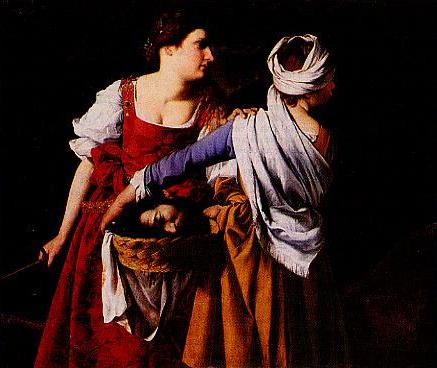The New Yorker, March 18, 2002, p.28:
Caption beneath Orazio's painting:
TWO HEADS ARE BETTER THAN ONE
In Orazio Gentileschi's "Judith and Her Maidservant" (1608-1609), the Hebrew heroine, having beheaded Holofernes, ponders her next move. As the Met's exhilarating show of works by Orazio and his better-known daughter, Artemisia, makes clear, themes of sex and violence run in the family. Often father and daughter treat the same material; Artemisia's gory version of the decapitation may well be, for lovingly nuanced shock, the "Psycho" shower scene of the Italian baroque. -Peter Schjeldahl
Description of exhibit at the Metropolitan Museum through May 12, 2002:
"Orazio and Artemisia Gentileschi: Father and Daughter Painters in Baroque Italy." Virtually the only woman painter among the fraternity of Old Masters, Artemisia Gentileschi has inspired novels, films, and a current play, thanks in part to speculation about her romantic misfortunes. Was she raped by her father's colleague? Or was she simply, as one sixties-era scholar put it, "a lascivious and precocious girl" who sued her lover for not making good on his marraige promises? Either way, she was a painter of great and often grisly refinement as this dual survey makes clear. Like Caravaggio, who inspired their realist style, the Gentileschis didn't skimp on skin, gold, velvet, or violence; Artemisia's depiction of Judith modelling a low-cut blue gown as she beheads a struggling Holofernes is a cleavage picture in both senses. While Artemisia rarely equalled the delicacy of her father's naturalism, she had a more focused eye for narrative nuance: note the way Judith has rolled up her sleeves before getting to work.


